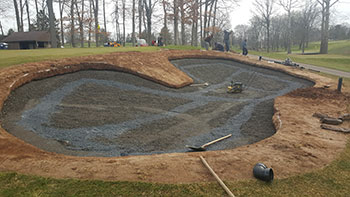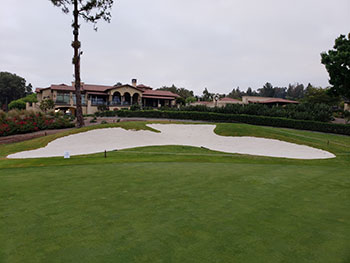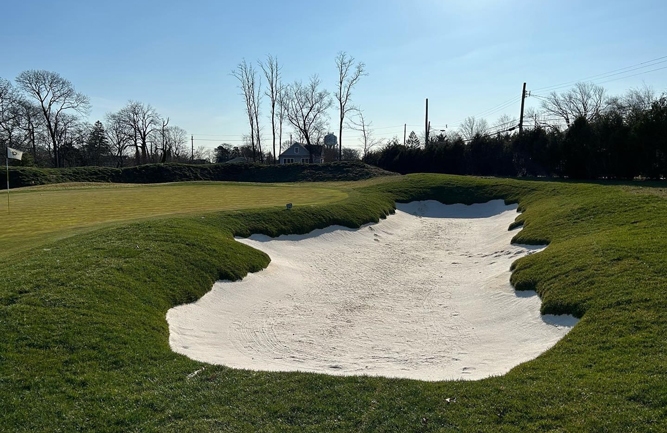Life’s a Beach

During photo of bunker renovation at Spring Ford CC (Photo: Spring Ford CC)
Two bad bunkers
When Spring Ford Country Club started having problems with two of its bunkers, they looked for a solution that would allow them a little flexibility
By Clara Richter
Anyone who has spent any portion of their life in northern climes knows what happens to roads after years of freezing and thawing during the fall, winter and early spring. If the freeze-thaw cycle can rip a pothole in asphalt, imagine what it can do to a bunker liner.
That was the thought running through the heads of Superintendent Mark Rubbo and the greens committee of Spring Ford Country Club in Royersford, Pa., when it came time to decide on a new bunker liner for two of their most problematic bunkers. And it’s one of the main reasons they chose Blinder Bunker.
“If you start to get all kinds of moisture and freezing and thawing, we thought it was safer to withstand the freeze-thaw cycles,” Rubbo explains. “All you have to do is drive around Pennsylvania. Whatever you’re driving on is solid material, whatever it is — concrete or asphalt — you get potholes. Things are subject to the freeze-thaw.”
Spring Ford CC has 60 bunkers, but so far only two have been renovated using Blinder Bunker. According to Rubbo, these bunkers were much worse than the others because they had surface water moving in from outside, which accelerated the damage and contamination.
“We were having problems with those in 2017. It was pretty wet and the two that we ended up doing got so washed out and so destroyed, the sand was completely contaminated,” Rubbo says. “They wouldn’t drain. That’s when we got searching for liners.”
Rubbo and the greens committee began the hunt for a solution by looking at the pros and cons of various bunker liners. They liked the flexibility of Blinder Bunker, as well as the fact that it wouldn’t damage clubs.
“There’s nothing in there that can scratch a golf club if you don’t have the sand perfect. They never really want to take a chance with gauging up clubs with anything that might be more solid underneath,” Rubbo laughs.
Once the course decided to move forward with Blinder Bunker, a certified installer — George E. Ley Co., out of Glenmoore, Penn. — came in and did the installation. The renovation took place in April 2018 and took about three or four days per bunker.
Rubbo saw immediate results. The course received two and a half inches of rain the weekend after the liners were installed and, according to Rubbo, not one grain of sand moved in either bunker. “We didn’t even turn a rake over to push a little ripple back,” he says.
“Everybody loves it,” Rubbo adds confidently.
Another thing everyone can agree on: The course needs 58 more Blinder-lined bunkers. Rubbo says they have had a lot of great side-by-side comparisons. “One looked like a bathtub, and the others, you’re ready to play golf.”
The course doesn’t have any plans to renovate the rest of its bunkers in the near future, but Rubbo says they might renovate a few here and there as issues pop up.

“After” photo of the bunker renovation at Mission Viejo CC (Photo: Mission Viejo CC)
Mission: Bunkers
Why bunker renovations were the first order of business for the new superintendent at Mission Viejo Country Club
By Sarah Webb
When Doug Rudolph become the superintendent of Mission Viejo (Calif.) Country Club in March 2018, his first order of business was to oversee the renovation of the club’s 60 bunkers.
Rudolph joined the Mission Viejo, Calif.-based club after 27 years at Pauma Valley Country Club in Pauma Valley, Calif., where he gained experience in handling bunker projects.
Rudolph says he was approached by Mission Viejo CC’s board of directors and greens committee about a bunker renovation. At that point, the bunkers were about 10 years old. They mentioned that the existing bunkers had nonplayable areas on the bottoms, torn lining that would poke through the sand and poor drainage, to boot.
“The previous bunker liner that was in there just wasn’t acceptable to the membership anymore,” Rudolph says. “We had to choose something else out there.”
After viewing bunker liners from three different companies and visiting a few local courses that had recently installed Polylast-lined bunkers, Mission Viejo CC settled on Polylast as its supplier.
In addition to installing new liner, Mission Viejo CC had many of the bunkers’ floors redone, new drainage installed and new sand brought in. The venue remained open during the renovations. In fact, Rudolph says the club typically saw between 150 and 200 rounds of golf per day during that time.
The club bid the project out to a local contractor, renovation began in September 2018 and was wrapped up by December 2018.
Despite the large number of bunkers and heavy rain that fell throughout the construction phase, Rudolph says the project ran smoothly.
“The experience of going through the process and listening to representatives from Polylast just made it easy,” Rudolph says.
He adds that at his previous course, he dealt with sand-based soil, and therefore, the bunkers that didn’t include liners. However, with Mission Viejo’s clay-based soil, Rudolph says the bunker lining and drainage systems are necessary.
“Having the bunker liner over the top of the clay really helps because you don’t get any ‘bleeding’ (like mud) through the sand,” Rudolph explains.
The bunkers complete, Rudolph says the club’s members are pleased with the results.
“(Our members) are ecstatic about the bunkers. I hear nothing but great comments about the bunkers almost every day,” Rudolph says.
Additionally, Mission Viejo’s crews have reaped the benefits of the improvements, according to Rudolph.
For example, in January alone, Mission Viejo received more than 7 inches of rain — a significantly higher amount than what’s typical for the area, according to Rudolph. In the past, such a high amount of rainfall would’ve caused serious damage, but Rudolph says his crews were able to clear the excess water and repair the edges of the bunkers in fewer than two hours.
“We still have very steep bunkers, but with the Polylast bunker liner, we did not have any major washouts at all,” Rudolph explains.
Satisfied with the final result, Rudolph says Mission Viejo CC doesn’t have any major bunker renovations on the horizon, but the club’s next major project will include renovating cart paths.
Check out the stories behind two additional bunker renovations here.












